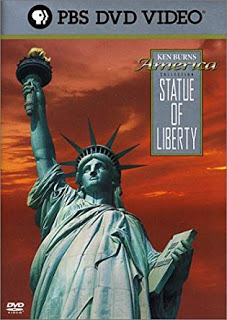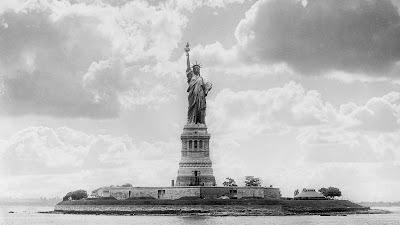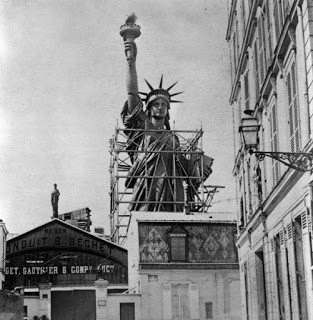Ken Burns - The Statue
of Liberty

Director:
Ken Burns
Year: 1985
Rating: 5.5
A few years after Ken Burns directed a documentary on the Brooklyn Bridge,
he turned to another iconic American monument The Statue of Liberty. It soars
above the New York Harbor quite majestic to see from the shore but especially
from the sea - but it is of course more than an inspiring structure - it
is an idea that has been firmly planted in the American imagination. It stands
for freedom. liberty, generosity and a welcome to those who come here. Or
it used to anyways. It has been badly tarnished in the past few years as
we close our doors to refugees in need and immigrants looking for a better
life. Perhaps the most heartfelt part of this documentary for me was simply
the videos of immigrants arriving at Ellis Island back at the beginning of
the 20th century looking tired and ragged, unable to speak English - thrilled
to have made it - and knowing that their children and their children's children
made a better life for themselves. As Mario Cuomo, the Governor of New York
at the time of the documentary says - I imagine my parents when they arrived
having a conversation with immigration officers saying we come with nothing,
no possessions, no money, no job - and I don't want much - just that someday
I want my son to be the Governor.
What is interesting is that the Statue was never meant to be a symbol of
immigration. It was a gift from the French to America celebrating 100 years
of democracy - something that France did not have at the time. The creator
Frédéric Auguste Bartholdi had already made a few large statues
and had in fact a design of a giant female figure that he tried to get the
Egyptians to commission but they declined. The idea of the statue was put
into his head by another Frenchman who advised Bartholdi to visit America.
He did - thought it was enormous and wonderful but that the people had no
taste or culture. Still true. The money was paid for by French citizens contributing
- but back in America they were responsible for the pedestal on which it
would stand - and no one wanted to pay for it. In fact, many people didn't
even want the statue - and Bartholdi considered moving it to Philadelphia
or Boston. Eventually, Pulitzer, the great newspaper publisher, got behind
the idea and the money was raised. The statue was built with the iron work
done by a fellow named Gustave Eiffel who a few years later designed another
famous monument. The pieces - as it had to be shipped over - sat on the Bedloe
Island for a year until the pedestal was completed. It was inaugurated in
1886 and nary a word was spoken about immigration.
And oddly though the documentary spends a lot of time talking about immigrants
and what the Statue symbolizes to them - Burns doesn't really address as
to how it became this symbol. Because even with Ellis Island only a short
distance away and boats arriving every day, there was no connection. Not
until Emma Lazarus came along. Before the statue was built she wrote a poem
in honor of it and the Russian Jews that were escaping a pogrom in that country.
And then the poem was forgotten. And she died a year after the statue was
commemorated. It wasn't until 1903 when a friend of Lazarus came across the
poem and lobbied to have a plaque installed on the statue with what became
her famous words and over time the Statue became what it is today - or at
least was.
Bartholdi claimed that it would stand forever and so it still does but we
know it won't always "They blew it up! God, damn you! Damn you all to hell!!!
"
The documentary seemed a bit lazy - an hour long but an awful lot of it is
filed with just images of the Statue and people saying how great it was and
what it meant. And he doesn't talk about Lazarus which just seems weird to
me.
The poem New Colossus.
Not like the brazen giant of Greek fame,
With conquering limbs astride from land to land;
Here at our sea-washed, sunset gates shall stand
A mighty woman with a torch, whose flame
Is the imprisoned lightning, and her name
Mother of Exiles. From her beacon-hand
Glows world-wide welcome; her mild eyes command
The air-bridged harbor that twin cities frame.
“Keep, ancient lands, your storied pomp!” cries she
With silent lips. “Give me your tired, your poor,
Your huddled masses yearning to breathe free,
The wretched refuse of your teeming shore.
Send these, the homeless, tempest-tost to me,
I lift my lamp beside the golden door!”




